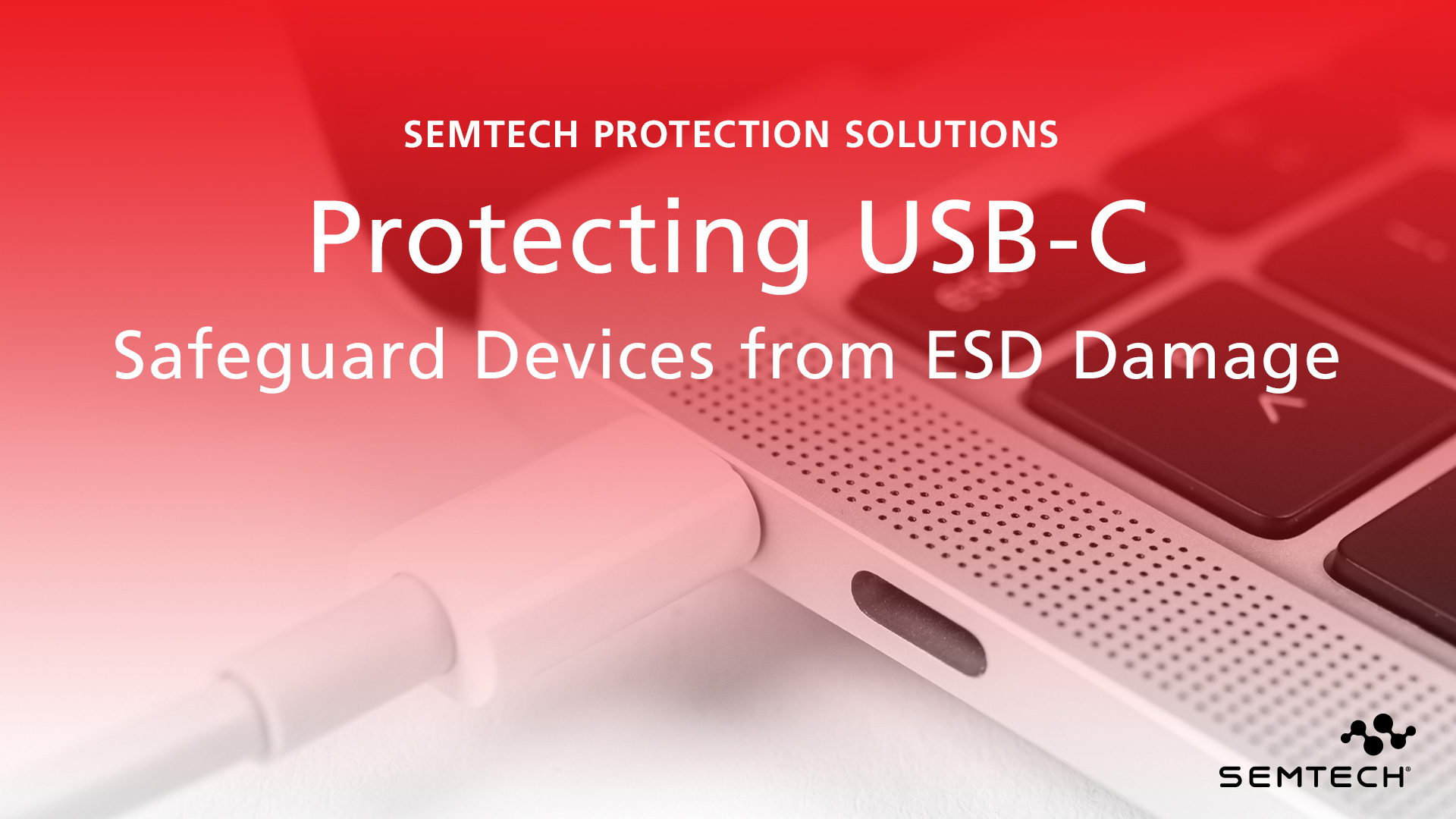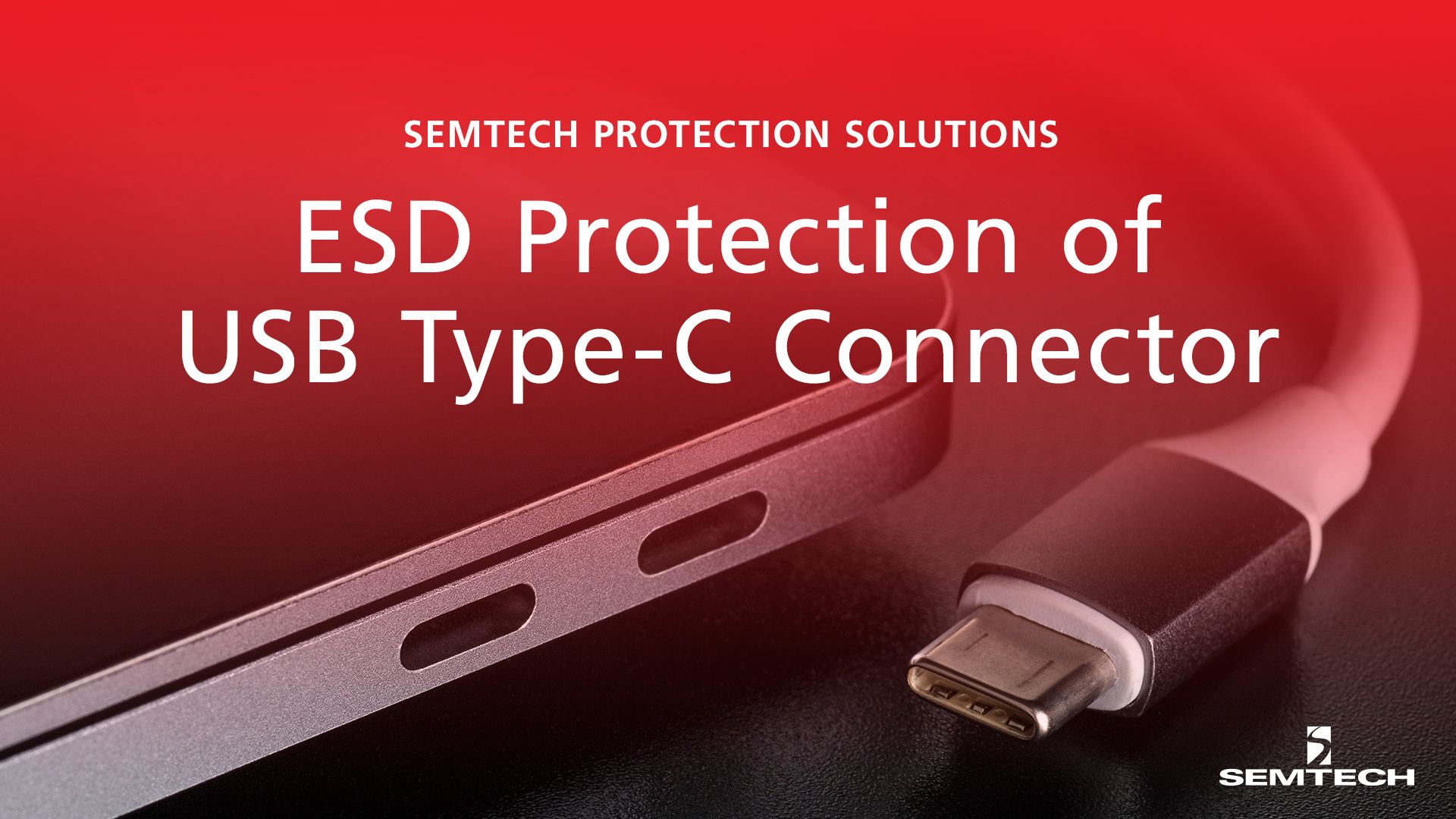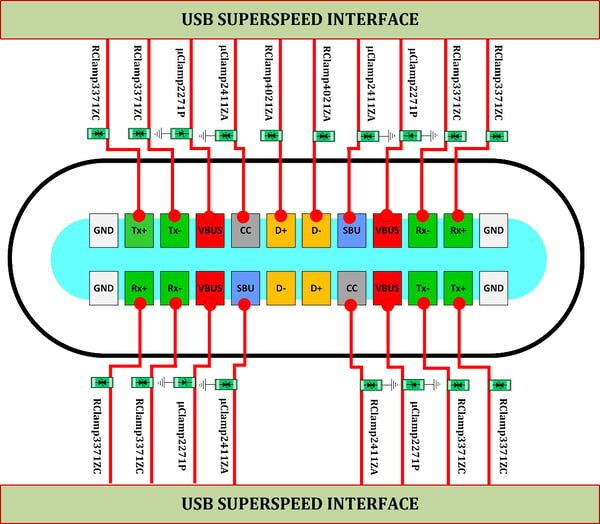ESD Protection of USB Type-C Interfaces
Imagine this common scenario: not having a spare Universal Serial Bus (USB) port on your computer. All your personal devices are connected. On most days, I carry a mobile phone, smart watch, wireless headset, and a Wi-Fi adapter – all of which can only be charged via a USB port. When I need to back up files on my computer, I often use a USB flash drive. When charging devices in the car, I use standard USB ports. USB is everywhere! It is so ingrained into our daily lives that it is a part of our every digital experience.
One of the most recent connectors, USB Type-C, is distinctly different from previous versions in terms of physical size as well as how it connects to host and peripheral devices. Designed to be reversible, USB Type-C inserts either face up or down and consists of the same set of 12 pins on its upper and lower side for a total of 24 pins. As for data transfer, USB Type-C supports up to 10Gbps and delivers up to 100W of power with the help of USB power delivery (USB PD). The VBUS voltage of 5V on previous USB versions is still supported. However, using USB PD, peripheral devices can select a VBUS voltage of up to 20V. The maximum current has been increased to 5A, making the maximum deliverable power 20x5=100W. With the USB PD feature, devices can be charged at a much faster rate, and this has made USB Type-C very popular for charging cellular phones, wireless headphones, drones, and some of the latest notebook models.

If USB PD is not required for any application, the VBUS can support 5V at 3A, for 15W deliverable power. USB Type-C can also work with prior USB versions including USB 2.0 and USB 3.0. Display protocols, such as DisplayPort and HDMI, are supported through alternate modes, and might need a connector adapter on one end of the cable.

Figure 1. USB Type C Pin Configurations © Semtech Corporation
Pin Configurations of USB Type-C
Figure 1 shows the pin configurations of USB Type-C. There are two differential pairs (D+ and D-), four pairs of SuperSpeed+ transmitter and receiver data buses (Tx+/Tx- and Rx+/Rx-), two Configuration Channel (CC) pins, two Side Band Use (SBU) pins, four VBUS pins, and four Ground pins (refer to Table 1 below).

Table 1: Pin Configuration of USB Type-C
The SBU pins correspond to low-speed signal paths and are used in the operation of alternate mode (Alt Mode). In Alt Mode, USB Type-C directly connects to HDMI or display port devices and transport display signals through USB Type-C cable. This feature of USB Type-C facilitates several popular data transmission systems in a single reversible tiny port without any additional electrical circuitry.
The Configuration Channel (CC) pins correspond to communication and configuration of plug orientation and connection management. The communication of power delivery (USB PD) options is done through the CC pins, also referred to as VCONN pins. One of the two CC pins in the USB Type-C port is used for orientation detection, while the other is used for initiating power delivery.

ESD Protection of USB Type-C
It is very important to protect USB interfaces from electrostatic discharges (ESD). We plug and unplug USB cables from our electronic gadgets many times daily, and when we touch or engage with the USB ports it is possible and common to generate electrostatic discharge. These ESD events can be generated either from a user (human body) or from stored charge on a cable. The electrostatic spike can reach up to tens of thousands of volts – easily capable of damaging the sensitive CMOS structures of the USB transceiver. Hence, ESD protection for each individual USB pin is not just important, it is essential. Considering the small size of the USB Type-C port and close proximity of its 24 pins, protecting the port from ESD is quite challenging. The two opposite sets of 12 pins are designed in such close proximity that a short circuit can occur when plugging the port into the device. It can also occur if conductive particles happen to form an unintended connection across the pins. Additional transient protection is always required to safeguard against this short circuit condition.
SBU and CC Pins Protection: Considering the tiny size of the USB Type-C plug and close positioning of its pins, discrete single-line transient voltage suppressor (TVS) diodes are well suited to protect the port from an ESD event. Moreover, discrete TVS diodes are also easier for the designer to layout and trace route. Referring to the pin configurations in Figure 1, we can see that CC pin and SBU pin are next to the VBUS pin. The VBUS pin can reach up to 20V, so if a short circuit condition occurs, the CC pin and SBU pin will be exposed to 20V. In this case, a TVS diode with a minimum 20V breakdown is required to protect the CC and SBU pins. Semtech’s µClamp2411ZA is capable of withstanding high ESD with voltages ranging from ±20kV (Air) and ±17kV (Contact) as per IEC 61000-4-2. It maintains an operating voltage of 24V. µClamp2411ZA is a bi-directional TVS diode with a low dynamic resistance of 1Ω and comes in an ultra-small 0201 packaging.
VBUS Pin Protection: Protecting VBUS pin requires a TVS diode with more than 20V of operating voltage, fast response time and low clamping voltage. Device performance degradation is not permissible during the protection of the VBUS pin. Low capacitance is not a consideration for the protection of VBUS line as it is generally not sensitive to additional capacitance. Semtech’s µClamp2271P is perfectly suited to safeguard the VBUS pin. The high power μClamp® has a working voltage of 22V with peak pulse current of 25A. Figure 2 shows the TVS protection options for VBUS, CC and SBU pins.
High-Speed Differential Lines Protection: Tx+/Tx- and Rx+/Rx- lines are used for super speed interfaces and alternate modes. Transmitter and receiver lines support 10Gbps of data transfer so it is clear that an ultra-small junction capacitance is critical to preserve signal integrity. Semtech’s RClamp3371ZC is characterized by a high ESD withstand voltage of ±17kV (Air) and ±10kV (Contact) per IEC 61000-4-2, and a working voltage of 3.3V maintaining a maximum capacitance of 0.25pF. The RClamp® comes in a tiny 0201 (0.6 x 0.3 x 0.25mm) package.
D+/D- Lines Protection: D+/D- lines are used for USB 2.0 interfaces. These lines can be protected by using Semtech’s RClamp4021ZA diodes. The RClamp4021ZA is a 4V TVS diode with a maximum junction capacitance of 0.55pF and low dynamic resistance of 0.12Ω (typical). It also comes in an ultra-small 0201(0.6 x 0.3 x 0.25mm) package. Figure 2 shows the ESD protection options for all differential lines.

Figure 2. ESD Protection of USB Type-C Port © Semtech Corporation
The USB Type-C interface, with its ultra-fast data transfer speed and superior power delivery capacity, is immensely popular in consumer, handheld and industrial electronic devices. With its popularity, these ports are routinely exposed to fast rise-time ESD spikes. As such, it is essential that USB ports are well safeguarded from the dangers of ESD threats. No user wants to experience a damaged headphone or a damaged smartphone due to an ESD event. Semtech’s highly efficient and trusted TVS products protect many of the world’s most popular electronics devices. These solutions are ideal for safeguarding USB 2.0 and USB Type-C interfaces – enabling consumers to enjoy a smooth uninterrupted experience interfacing their high-performance electronic gadgets.
Learn more about Semtech’s Circuit Protection products at the link below.
Semtech®, the Semtech logo, RClamp®, and μClamp® are registered trademarks or service marks of Semtech Corporation or its affiliates. Other product or service names mentioned herein may be the trademarks of their respective owners.
